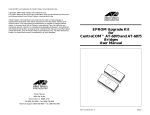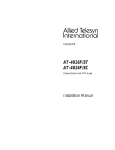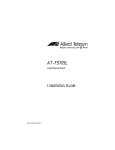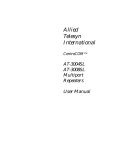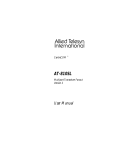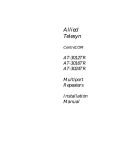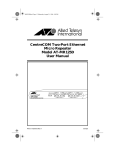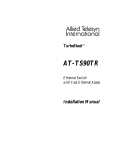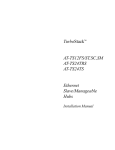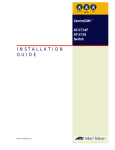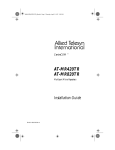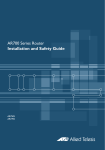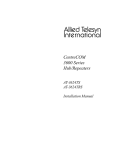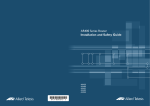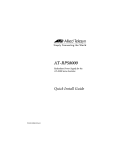Download AT-3012T User Manual
Transcript
Allied Telesyn CentreCOM™ AT-3012T Multiport Repeater User Manual Copyright 1994 Allied Telesyn International, Corp. All rights reserved. No part of this publication may be reproduced without prior written permission from Allied Telesyn International, Corp. Allied Telesyn International, Corp. reserves the right to make changes in specifications and other information contained in this document without prior written notice. The information provided herein is subject to change without notice. In no event shall Allied Telesyn International, Corp. be liable for any incidental, special, indirect, or consequential damages whatsoever, including but not limited to lost profits, arising out of or related to this manual or the information contained herein, even if Allied Telesyn International, Corp. has been advised of, known, or should have known, the possibility of such damages. Trademarks: CentreCOM is a registered trademark of Allied Telesyn International, Corp. Ethernet is a registered trademark of Xerox Corporation. UNIX is a registered trademark of UNIX System Laboratories. Novell and NetWare are registered trademarks of Novell, Inc. Microsoft and MS-DOS are registered trademarks and LAN Manager and Windows for Workgroups are trademarks of Microsoft Corporation. 3Com is a registered trademark of 3Com. PC-NFS is a trademark of Sun Microsystems, Inc. PC/TCP is a registered trademark of FTP Software, Inc. RADIATED ENERGY U.S. Federal Communications Note: This equipment has been tested and found to comply with the limits for a Class A digital device pursuant to Part 15 of FCC Rules. These limits are designed to provide reasonable protection against harmful interference when the equipment is operated in a commercial environment. This equipment generates, uses, and can radiate radio frequency and, if not installed and used in accordance with this instruction manual, may cause harmful interference to radio communications. Operation of this equipment in a residential area is likely to cause harmful interference in which case the user will be required to correct the interference at his own expense. Electrical Safety and Installation Requirements Note: Modifications or changes not expressly approved by the manufacturer or the FCC, can void your right to operate this equipment. Canadian Department of Communications This digital apparatus does not exceed the Class A limits for radio noise emissions from digital apparatus as set out in the radio interference regulations of the Canadian Department of Communications. Le présent appariel numérique n'émet pas de bruits radioélectriques dépassant les limites appicables aux appariels numériques de Classe A. Prescrites dans le réglement sur le brouillage radioélectrique édicté par le minestére des Communications Du Canada. Warning Caution ! SAFETY ELECTRICAL NOTICES WARNING: ELECTRIC SHOCK HAZARD To prevent ELECTRIC shock, do not remove cover. No user-serviceable parts inside. This unit contains HAZARDOUS VOLTAGES and should only be opened by a trained and qualified technician. To avoid the possibility of ELECTRIC SHOCK, disconnect electric power to the product before connecting or disconnecting the LAN cables. LIGHTNING DANGER DANGER: DO NOT WORK on equipment or CABLES during periods of LIGHTNING ACTIVITY. CAUTION: POWER CORD IS USED AS A DISCONNECTION DEVICE. TO DE-ENERGISE EQUIPMENT, disconnect the power cord. INSTALLATION ELECTRICAL—AUTO VOLTAGE ADJUSTMENT This product will automatically adjust to any voltage between the ranges shown on the label. ELECTRICAL—TYPE CLASS 1 EQUIPMENT THIS EQUIPMENT MUST BE EARTHED. Power plug must be connected to a properly wired earth ground socket outlet. An improperly wired socket outlet could place hazardous voltages on accessible metal parts. ELECTRICAL—CORD NOTICE Use power cord, maximum 4.5 meters long, rated 6 amp minimum, 250V, made of HAR cordage molded IEC 320 connector on one end and on the other end a plug approved by the country of end use. Caution ! MOUNTING INSTRUCTIONS CAUTION: These models are designed for operation in the HORIZONTAL position. VERTICAL MOUNTING must not be done without the use of an Allied Telesyn vertical mount chassis designed for this purpose. CAUTION: Air vents must not be blocked and must have free access to the room ambient air for cooling. CAUTION: DO NOT detach rubber feet from the product unless an Allied Telesyn vertical mounting chassis is being used. OPERATING TEMPERATURE This product is designed for a maximum ambient temperature of 50° C. ALL COUNTRIES: Install product in accordance with local and National Electrical Codes. Achtung SICHERHEIT ACHTUNG: GEFÄHRLICHE SPANNUNG Das Gehäuse nicht öffnen. Das Gerät enthält keine vom Benutzer wartbaren Teile. Das Gerät steht unter Hochspannung und darf nur von qualifiziertem technischem Personal geöffnet werden. Vor Anschluß der LAN-Kabel, Gerät vom Netz trennen. GEFAHR DURCH BLITZSCHLAG GEFAHR: Keine Arbeiten am Gerät oder an den Kabeln während eines Gewitters ausführen Vorsicht ! VORSICHT: DAS NETZKABEL DIENT ZUM TRENNEN DER STROMVERSORGUNG. ZUR TRENNUNG VOM NETZ, KABEL AUS DER VORSICHT STECKDOSE ZIEHEN. INSTALLATION AUTOMATISCHE SPANNUNGSEINSTELLUNG Dieses Gerät stellt sich automatisch auf die auf dem Etikett aufgeführten Spannungswerte ein. KLASSE 1 GERÄTE DIESE GERÄTE MÜSSEN GEERDET SEIN. Der Netzstecker darf nur mit einer vorschriftsmäßig geerdeten Steckdose verbunden werden. Ein unvorschriftsmäßiger Anschluß kann das Metallgehäuse Teile unter gefährliche elektrische Spannungen setzen. i NETZKABEL Das Netzkabel sollte eine maximale Länge von 4,5 Metern, einen Nennwert von mindestens 6 A und 250 V haben, aus HAR-Material hergestellt und mit einer gepreßten, IEC 320 entsprechenden, Anschlußverbindung an einem Ende, und am anderen Ende mit einem im Land des Endverbrauchers geprüften Stecker ausgestattet sein. Vorsicht ! MONTAGEANWEISUNGEN VORSICHT: Diese Modelle sind für Betrieb in horizontaler Position entworfen worden. Das Gerät darf NICHT OHNE Gebrauch eines dafür entworfenen Allied Telesyn-Vertikalmontagegestells in VERTIKALER Position montiert werden. VORSICHT: Die Entlüftungsöffnungen dürfen nicht versperrt sein und müssen zum Kühlen freien Zugang zur Raumluft haben. VORSICHT: Die Gummifüße NICHT ENTFERNEN, außer bei Gebrauch des Allied Telesyn-Vertikalmontagegestells. BETRIEBSTEMPERATUR Dieses Produkt wurde für den Betrieb in einer Umgebungstemperatur von nicht mehr als 50˚ C entworfen. ALLE LÄNDER: Installation muß örtlichen und nationalen elektrischen Vorschriften entsprechen. STRÅLINGSENERGI Dette kommercielle produkt opfylder de krav, der i USA stilles til udstyr af Klasse A. Advarsel SIKKERHED ELEKTRISKE FORHOLDSREGLER ADVARSEL: RISIKO FOR ELEKTRISK STØD For at forebygge ELEKTRISK stød, undlad at åbne apparatet. Der er ingen indre dele, der kan repareres af brugeren. Denne enhed indeholder LIVSFARLIGE STRØMSPÆNDINGER og bør kun åbnes af en uddannet og kvalificeret tekniker. For at undgå risiko for ELEKTRISK STØD, afbrydes den elektriske strøm til produktet, før LAN-kablerne monteres eller afmonteres. Advarsel FARE UNDER UVEJR FARE: UNDLAD at arbejde på udstyr eller KABLER i perioder med LYNAKTIVITET. ! ADVARSEL: DEN STRØMFØRENDE LEDNING BRUGES TIL AT AFBRYDE STRØMMEN. SKAL STRØMMEN TIL APPARATET AFBRYDES, tages ledningen ud af stikket. INSTALLATION ELEKTRISK—AUTOMATISK SPÆNDINGSREGULERING Dette apparat vil automatisk tilpasse sig enhver spænding indenfor de værdier, der er angivet på etiketten. ELEKTRISK—KLASSE 1-UDSTYR DETTE UDSTYR KRÆVER JORDFORBINDELSE. Stikket skal være forbundet med en korrekt installeret jordforbunden stikkontakt. En ukorrekt installeret stikkontakt kan sætte livsfarlig spænding til tilgængelige metaldele. ELEKTRISK—LEDNING Anvend ledning af maksimum 4,5 meters længde, med en kapacitet på minimum 6 amp., 250 v, bestående af en IEC 320 connector med indstøbt HAR ledning i den ene ende og et stik i den anden ende godkendt der er af myndighederne i brugerlandet. Advarsel ! INSTRUKTIONER FOR OPSTILLING ADVARSEL: Disse modeller er konstrueret til at betjenes i HORISONTAL position (vandret). VERTIKAL OPSTILLING (lodret) må IKKE FORETAGES uden brug af et Allied Telesyn vertikalt monteringsstel konstrueret til dette formål. ADVARSEL: Ventilationsåbninger må ikke blokeres og skal have fri adgang til den omgivende luft i rummet for afkøling. ADVARSEL: UNDLAD at fjerne gummisoklerne fra apparatet, med mindre der anvendes et Allied Telesyn vertikalt monteringsstel. BETJENINGSTEMPERATUR Dette apparat er konstrueret til en omgivende temperatur på maksimum 50 grader C. ALLE LANDE: Installation af produktet skal ske i overensstemmelse med lokal og national lovgivning for elektriske installationer. STRALINGSENERGIE Dit handelsprodukt werd getest en voldoet aan de Amerikaanse vereisten voor een klasse A toestel. Waarschuwingen VEILIGHEID WAARSCHUWINGEN MET BETREKKING TOT ELEKTRICITEIT WAARSCHUWING: GEVAAR VOOR ELEKTRISCHE SCHOKKEN Gelieve het deksel niet te verwijderen, teneinde ELEKTRISCHE schokken te voorkomen. Binnenin bevinden zich geen onderdelen die door de gebruiker kunnen worden onderhouden. Dit toestel staat onder GEVAARLIJKE SPANNING en mag alleen worden geopend door een daartoe opgeleide en bevoegde technicus. Om het gevaar op ELEKTRISCHE SCHOKKEN te vermijden, moet u het toestel van de stroombron ontkoppelen alvorens de LAN-kabels te koppelen of ontkoppelen. GEVAAR VOOR BLIKSEMINSLAG Waarschuwingen GEVAAR: NIET aan toestellen of KABELS WERKEN bij BLIKSEM. ! WAARSCHUWING: HET TOESTEL WORDT UITGESCHAKELD DOOR DE STROOMKABEL TE ONTKOPPELEN. OM HET TOESTEL STROOMLOOS TE MAKEN: de stroomkabel ontkoppelen. INSTALLATIE ELEKTRISCH—AUTOMATISCHE AANPASSING VAN DE SPANNING Dit toestel past zich automatisch aan elke spanning aan, tussen de waarden op het label vermeld. ii ELEKTRISCHE—TOESTELLEN VAN KLASSE 1 DIT TOESTEL MOET GEAARD WORDEN. De stekker moet aangesloten zijn op een juist geaarde contactdoos. Een onjuist geaarde contactdoos kan de metalen onderdelen waarmee de gebruiker eventueel in aanraking komt onder gevaarlijke spanning stellen. ELEKTRISCHE—SNOEREN Gebruik een elektrisch snoer, maximum 4,5 meter lang, berekend voor ten minste 6 ampère, 250 V, uit HAR vervaardigd, met aan het ene uiteinde een gevormde IEC 320 stekker en aan het andere uiteinde een stekker die goedgekeurd is door het land waar het toestel zal worden gebruikt. MONTAGE-INSTRUCTIES Waarschuwingen WAARSCHUWING: Deze modellen zijn ontworpen om te werken in HORIZONTALE stand. VERTICALE MONTAGE mag NIET UITGEVOERD WORDEN, tenzij een daartoe speciaal ontworpen Allied Telesyn chassis voor verticale montage wordt gebruikt. ! WAARSCHUWING: De ventilatiegaten mogen niet worden gesperd en moeten de omgevingslucht ongehinderd toelaten voor afkoeling. WAARSCHUWING: De rubberen voetjes NIET van het produkt LOSMAKEN behalve wanneer een chassis voor vertikale montage van Allied Telesyn wordt gebruikt. BEDRIJFSTEMPERATUUR De omgevingstemperatuur voor dit produkt mag niet meer bedragen dan 50 graden Celsius. ALLE LANDEN: het toestel installeren overeenkomstig de lokale en nationale elektrische voorschriften. ENERGIE RAYONNEE Ce matériel a été testé et est certifié conforme par la réglementation américaine aux normes définies pour les appareils de classe A. Avertissement Danger ! SECURITE INFORMATION SUR L’ELECTRICITE AVERTISSEMENT: DANGER D’ELECTROCUTION Pour empêcher les dangers d’ELECTROCUTION, ne pas enlever le couvercle. L’équipement ne contient aucun élément réparable par l’utilisateur. Cet appareil comprend des TENSIONS DANGEREUSES et ne doit être ouvert que par un technicien dûment qualifié. Pour éviter tout risque d’ELECTROCUTION, débrancher l’appareil de la prise de courant avant de connecter ou de déconnecter les câbles LAN. DANGER DE FOUDRE DANGER: NE PAS MANIER l’équipement ou les CABLES pendant les périodes d’activité orageuse. ATTENTION: LE CORDON D’ALIMENTATION SERT DE MISE HORS CIRCUIT POUR COUPER L’ALIMENTATION DE L’APPAREIL, débranchez le cordon. INSTALLATION ELECTRICITE—REGLAGE DE TENSION AUTOMATIQUE Ce produit peut s’ajuster automatiquement sur n’importe quelle tension comprise dans la plage indiquée sur le label. ELECTRICITE—EQUIPEMENT DE CLASSE 1 CET APPAREIL DOIT ETRE MIS A LA TERRE. La prise de courant doit être branchée dans une prise femelle correctement mise à la terre. Sinon, des tensions dangereuses risqueraient d’atteindre les pièces métalliques accessibles à l’utilisateur. ELECTRICITE—INFORMATION SUR LE CORDON Utiliser un cordon secteur de 4,5 mètres de long maximum, calibré à 6 ampères minimum, 250V, et fabriqué en câblage HAR avec connecteur IEC 32C moulé à une extrémité et à l’autre extrémité, une prise de courant mâle répondant aux normes du pays d’utilisation. Attention ! INSTRUCTIONS DE MONTAGE ATTENTION: Ces modèles sont destiné à fonctionner en position horizontale. L’appareil NE DOIT PAS être utilisé en MONTAGE VERTICAL sans employer un châssis de montage vertical Allied Telesyn conçu à cet effet. ATTENTION: Ne pas bloquer les fentes d’aération, ce qui empêcherait l’air ambiant de circuler librement pour le refroidissement. ATTENTION: Ne pas ôter les pattes d’attache en caoutchouc du produit, à moins d’utiliser un châssis de montage vertical Allied Telesyn. TEMPERATURE DE FONCTIONNEMENT Ce produit est capable de tolérer une température ambiante maximum de 50 degrés Celsius POUR TOUS PAYS: Installer le produit conformément aux normes électriques nationales et locales. SÄTEILYENERGIA Tämä kaupallinen tuote on testattu ja noudattaa Yhdysvaltojen vaatimuksia luokan A laitteelle. Varoitus Hengenvaara ! TURVALLISUUS SÄHKÖÖN LIITTYVIÄ HUOMAUTUKSIA VAROITUS: SÄHKÖISKUVAARA Estääksesi SÄHKÖISKUN älä poista kantta. Sisällä ei ole käyttäjän huollettavissa olevia osia. Tämä laite sisältää VAARALLISIA JÄNNITTEITÄ ja sen voi avata vain koulutettu ja pätevä teknikko. Välttääksesi SÄHKÖISKUN mahdollisuuden katkaise sähkövirta tuotteeseen ennen kuin liität tai irrotat paikallisverkon (LAN) kaapelit. SALAMANISKUVAARA HENGENVAARA: ÄLÄ TYÖSKENTELE laitteiden tai KAAPELEIDEN KANSSA SALAMOINNIN AIKANA. HUOMAUTUS: VIRTAJOHTOA KÄYTETÄÄN VIRRANKATKAISULAITTEENA. VIRTA KATKAISTAAN irrottamalla virtajohto. iii ASENNUS SÄHKÖ —AUTOMAATTINEN JÄNNITTEENSÄÄTÖ Tämä tuote säätää automaattisesti mihin tahansa jännitteeseen ohjetarrassa annettujen arvojen välillä. SÄHKÖ —TYYPPILUOKAN 1 LAITTEET TÄMÄ LAITE TÄYTYY MAADOITTAA. Pistoke täytyy liittää kunnollisesti maadoitettuun pistorasiaan. Virheellisesti johdotettu pistorasia voi altistaa metalliosat vaarallisille jännitteille. SÄHKÖ —JOHTOON LIITTYVÄ HUOMAUTUS Käytä seuraavanlaista virtajohtoa: maksimipituus 4,5 metriä, minimiteho 6 ampeeria, 250 V, valmistettu HAR-johdostosta, muovattu IEC 320 -liitin toisessa päässä ja käyttömaassa hyväksytty pistoke toisessa päässä. Huomautus ! ASENNUSSOHJEET HUOMAUTUS: Nämä mallit on suunniteltu käytettäviksi VAAKA-asennossa. PYSTYASENNUSTA EI SAA TEHDÄ ilman Allied Telesyn -pystykiinnitysalustaa, joka on suunniteltu tähän tarkoitukseen. HUOMAUTUS: Ilmavaihtoreikiä ei pidä tukkia ja niillä täytyy olla vapaa yhteys ympäröivään huoneilmaan, jotta ilmanvaihto tapahtuisi. HUOMAUTUS: ÄLÄ irroita kumijalkoja tuotteesta, ellei Allied Telesyn-pystykiinnitysalusta ole käytössä. KÄYTTÖLÄMPÖTILA Tämä tuote on suunniteltu ympäröivän ilman maksimilämpötilalle 50° C. KAIKKI MAAT: Asenna tuote paikallisten ja kansallisten sähköturvallisuusmääräysten mukaisesti. ENERGIA IRRADIATA Questo prodotto commerciale è stato collaudato e risponde ai requisiti U.S.A. per i dispositivi di classe A. Attenzione NORME DI SICUREZZA AVVERTENZE ELETTRICHE ATTENZIONE: PERICOLO DI SCOSSE ELETTRICHE Per evitare SCOSSE ELETTRICHE non asportare il coperchio. Le componenti interne non sono riparabili dall’utente. Questa unità ha TENSIONI PERICOLOSE e va aperta solamente da un tecnico specializzato e qualificato. Per evitare ogni possibilità di SCOSSE ELETTRICHE, interrompere l’alimentazione del dispositivo prima di collegare o staccare i cavi LAN. Pericolo PERICOLO DI FULMINI PERICOLO: NON LAVORARE sul dispositivo o sui CAVI durante PRECIPITAZIONI TEMPORALESCHE. ! ATTENZIONE: IL CAVO DI ALIMENTAZIONE È USATO COME DISPOSITIVO DI DISATTIVAZIONE. PER TOGLIERE LA CORRENTE AL DISPOSITIVO staccare il cavo di alimentazione. INSTALLAZIONE ELETTRICITÀ—REGOLAZIONE AUTOMATICA DELLA TENSIONE Questo prodotto regolerà automaticamente la tensione ad un valore compreso nella gamma indicata sull’etichetta. ELETTRICITÀ—DISPOSITIVI DI CLASSE 1 QUESTO DISPOSITIVO DEVE AVERE LA MESSA A TERRA. La spina deve essere inserita in una presa di corrente specificamente dotata di messa a terra. Una presa non cablata in maniera corretta rischia di scaricare una tensione pericolosa su parti metalliche accessibili. ELETTRICITÀ—AVVERTENZA SUL CAVO Usare un cavo della lunghezza massima di metri 4,5, con capacità minima di 6 A, 250 V, di filo HAR, dotato di connettore stampato IEC 320 ad un’estremità e di spina approvata dal paese di destinazione all’altra. Attenzione ! ISTRUZIONI PER IL MONTAGGIO ATTENZIONE: questi modelli sono concepiti per il funzionamento in posizione ORIZZONTALE. NON È POSSIBILE EFFETTUARE IL MONTAGGIO VERTICALE senza utilizzare l’apposito telaio per il montaggio verticale Allied Telesyn. ATTENZIONE: le prese d’aria non vanno ostruite e devono consentire il libero ricircolo dell’aria ambiente per il raffreddamento. ATTENZIONE: NON staccare il piedino in gomma dal prodotto tranne qualora si utilizzi il telaio Allied Telesyn per il montaggio verticale. TEMPERATURA DI FUNZIONAMENTO Questo prodotto è concepito per una temperatura ambientale massima di 50 gradi centigradi. TUTTI I PAESI: installare il prodotto in conformità alle vigenti normative elettriche nazionali. UTSTRÅLT ENERGI Dette kommersielle produktet har blitt testet og er i samsvar med amerikanske krav for et A-Klasse apparat. Advarsel Fare ! iv SIKKERHET ELEKTRISKE MEDDELELSE ADVARSEL: FARE FOR ELEKTRISK SJOKK For å unngå ELEKTRISK sjokk, må dekslet ikke tas av. Det finnes ingen deler som du kan bruke på innsiden. Denne enheten inneholder FARLIGE SPENNING, og må kun åpnes av en opplært, kvalifisert tekniker. For å unngå muligheten av ELEKTRISK SJOKK, må den elektriske strømmen til produktet være av når du slår LAN-ledninger av og på. FARE FOR LYNANTENNELSE FARE: MÅ IKKE BRUKES på utstyr eller ledninger mens LYN-AKTIVITET er i gang. FORSIKTIG: STRØMLEDNINGEN BRUKES TIL Å SLÅ APPARATET AV. HVIS DU VIL DEAKTIVISERE UTSTYRET, må du fjerne strømledningen. INSTALLASJON ELEKTRISK—AUTO SPENNINGSTILPASSING Dette produktet vil automatisk bli tilpasset hvilken som helst strøminnstilling i de områdene som vises på etiketten. ELEKTRISKE—TYPE 1. KLASSE UTSTYR DETTE UTSTYRET MÅ JORDES. Strømkontakten må være tilkoplet en korrekt jordet grunnstøpselkontakt. En støpselkontakt som ikke er jordet på rett måte, kan tilføre farlig spenning til lett tilgjengelige metalldeler. ELEKTRISKE—MEDDELELSE OM LEDNINGER Bruk en strømledning av maksimal størrelse 4,5 m i lengde, vurdert for minst av 6 amp, 250V, fremstilt av HAR ledning IEC 320 koplingsstykke på den ene kanten og på den andre kanten en plugg som har blitt godkjent i det landet hvor den siste brukeren befinner seg. Forsiktig ! BRUKSANVISNINGER FOR MONTERING FORSIKTIG: Disse modellene er beregnet til bruk i HORISONTAL stilling. VERTIKAL MONTERING må IKKE UTFØRES uten bruk av et Allied Telesyn vertikal monteringschassis som er spesiallaget til dette formål. FORSIKTIG: Luftventilene må ikke blokkeres og må ha fri tilgang til luft med romtemperatur for avkjøling. FORSIKTIG: Gummiføttene må IKKE fjernes fra produktet med mindre en Allied Telesyn vertikal monteringschassis er i bruk. DRIFTSTEMPERATUR Dette produktet har blitt fremstilt til bruk med maksimum romtemperatur på 50 grader celsius. ALLE LAND: Produktet må installeres i samsvar med de lokale og nasjonale elektriske koder. ENERGIA IRRADIADA Este produto foi testado e atende aos requisitos para dispositivos comerciais de Classe A nos E.U.A. Atenção Perigo ! SEGURANÇA AVISOS SOBRE CARACTERÍSTICAS ELÉTRICAS ATENÇÃO: PERIGO DE CHOQUE ELÉTRICO Para evitar CHOQUE ELÉTRICO, não retire a tampa. Não contém peças que possam ser consertadas pelo usuário. Este aparelho contém VOLTAGENS PERIGOSAS e só deve ser aberto por um técnico qualificado e treinado. Para evitar a possibilidade de CHOQUE ELÉTRICO, desconecte o aparelho da fonte de energia elétrica antes de conectar e desconectar os cabos da LAN. PERIGO DE CHOQUE CAUSADO POR RAIO PERIGO: NÃO TRABALHE no equipamento ou nos CABOS durante períodos suscetíveis de QUEDAS DE RAIO. CUIDADO: O CABO DE ALIMENTAÇÃO É UTILIZADO COMO UM DISPOSITIVO DE DESCONEXÃO. PARA DESELETRIFICAR O EQUIPAMENTO desconecte o cabo de alimentação. INSTALAÇÃO ELÉTRICO—AJUSTE AUTOMÁTICO DE VOLTAGEM Este produto ajustar-se-á automaticamente a qualquer voltagem que esteja dentro dos limites indicados no rótulo. ELÉTRICO—EQUIPAMENTOS DO TIPO CLASSE 1 DEVE SER FEITA LIGAÇÃO DE FIO TERRA PARA ESTE EQUIPAMENTO. O plugue deve ser conectado a uma tomada com ligação de fio terra. Tomadas sem ligação de fio terra podem transmitir voltagens perigosas a peças metálicas expostas. ELÉTRICO—AVISO SOBRE O CABO DE ALIMENTAÇÃO Use cabo de alimentação com comprimento máximo de 4,5 metros, com uma capacidade mínima de 6 amp e 250 V, fabricado de material para cabo HAR com conector moldado IEC 320 em uma extremidade e, na outra extremidade, um plugue aprovado para uso no país em questão . Cuidado ! INSTRUÇÕES DE INSTALAÇÃO CUIDADO: Este modelos foram projetados para funcionar na posição HORIZONTAL. NÃO DEVE SER EFETUADA INSTALAÇÃO VERTICAL sem o uso de um chassis de montagem vertical Allied Telesyn projetado para este fim específico. CUIDADO: As entradas de ar não devem ser bloqueadas e devem ter acesso livre ao ar ambiente para arrefecimento adequado do aparelho. CUIDADO: NÃO RETIRE os calços de borracha do produto a menos que esteja sendo usado um chassis de montagem vertical Allied Telesyn. TEMPERATURA DE FUNCIONAMENTO Este produto foi projetado para uma temperatura ambiente máxima de 50 graus centígrados. TODOS OS PAÍSES: Instale o produto de acordo com as normas federais e locais para instalações elétricas. ENERGIA RADIADA Este producto comercial ha sido probado y cumple con las normas requeridas en los EE. UU. para un dispositivo de Clase A. Advertencia Peligro ! SEGURIDAD AVISOS ELECTRICOS ADVERTENCIA: PELIGRO DE ELECTROCHOQUE Para evitar un ELECTROCHOQUE, no quite la tapa. No hay ningún componente en el interior al cual puede prestar servicio el usuario. Esta unidad contiene VOLTAJES PELIGROSOS y sólo deberá abrirla un técnico entrenado y calificado. Para evitar la posibilidad de ELECTROCHOQUE desconecte la corriente eléctrica que llega al producto antes de conectar o desconectar los cables LAN. PELIGRO DE RAYOS PELIGRO: NO REALICE NINGUN TIPO DE TRABAJO O CONEXION en los equipos o en LOS CABLES durante TORMENTAS DE RAYOS v ATENCION: EL CABLE DE ALIMENTACION SE USA COMO UN DISPOSITIVO DE DESCONEXION. PARA DESACTIVAR EL EQUIPO, desconecte el cable de alimentación. INSTALACION ELECTRICO—AUTO-AJUSTE DE TENSION Este producto se ajustará automáticamente a cualquier tensión entre los valores máximos y mínimos indicados en la etiqueta. ELECTRICO—EQUIPO DEL TIPO CLASE 1 ESTE EQUIPO TIENE QUE TENER CONEXION A TIERRA. El cable tiene que conectarse a un enchufe con tierra debidamente instalado. Un enchufe que no está correctamente instalado podría ocasionar tensiones peligrosas en las partes metálicas están expuestas. ELECTRICO—ADVERTENCIA SOBRE EL CABLE Use un cable eléctrico con un máximo de 4,5 metros de largo, con una capacidad mínima de 6 amperios, 250 V, hecho de cable HAR, con el conector moldeado IEC 320 en un extremo y con un enchufe que está aprobado por el país de uso final en el otro. Attencion ! INSTRUCCIONES DE MONTAJE ATENCION: Estos modelos están diseñados para operar en posición HORIZONTAL. NO SE DEBEN MONTAR VERTICALMENTE sin el uso de un chasis de montaje vertical de Allied Telesyn que se ha diseñado para este fin. ATENCION: Las aberturas para ventilación no deberán bloquearse y deberán tener acceso libre al aire ambiental de la sala para su enfriamiento. ATENCION: NO separe las patas de goma del producto a menos que se esté usando un chasis de montaje vertical de Allied Telesyn. TEMPERATURA REQUERIDA PARA LA OPERACIÓN Este producto está diseñado para una temperatura ambiental máxima de 50 grados C. PARA TODOS LOS PAÍSES: Monte el producto de acuerdo con los Códigos Eléctricos locales y nacionales. ENERGIUTSTRÅLNING Denna handelsprodukt har testats och befunnits vara i enlighet med U.S.A.s krav för klass A utrustning. Varning Fara ! SÄKERHET TILLKÄNNAGIVANDEN BETRÄFFANDE ELEKTRICITETSRISK: RISK FÖR ELEKTRISK STÖT För att undvika ELEKTRISK stöt, ta ej av locket. Det finns inga delar inuti som behöver underhållas. Denna apparat är under HÖGSPÄNNING och får endast öppnas av en utbildad kvalificerad tekniker. För att undvika ELEKTRISK STÖT, koppla ifrån produktens strömanslutning innan LAN-kablarna ansluts eller kopplas ur. FARA FÖR BLIXTNEDSLAG FARA: ARBETA EJ på utrustningen eller kablarna vid ÅSKVÄDER. VARNING: NÄTKABELN ANVÄNDS SOM STRÖMBRYTARE FÖR ATT KOPPLA FRÅN STRÖMMEN, dra ur nätkabeln. INSTALLATION ELEKTRISKT—AUTOMATISK SPÄNNINGSJUSTERING Denna produkt justeras automatiskt till alla spänningar inom omfånget som indikeras på produktens märkning. ELEKTRISKT—TYP KLASS 1 UTRUSTNING DENNA UTRUSTNING MÅSTE VARA JORDAD. Nätkabeln måste vara ansluten till ett ordentligt jordat uttag. Ett felaktigt uttag kan göra att närliggande metalldelar utsätts för högspänning. Apparaten skall anslutas till jordat uttag, när den ansluts till ett nätverk. ELEKTRISKT—ANMÄRKNING BETRÄFFANDE KABELN Använd en kabel med maximum längd 4,5 meter och minimum 6 amp nominal, 250V, av HAR kabelfabrikat med ett specialutformat IEC 320-kontaktdon i ena änden och i den andra en plugg som godkänts i landet där produkten används. Varning ! MONTERINGSINSTRUKTIONER VARNING: Dessa modeller är konstruerade för användning i HORISONTALLÄGE. VERTIKALMONTERING får EJ UTFÖRAS utan att ett Allied Telesyn specialkonstruerat vertikalt monteringschassi används. VARNING: Luftventilerna får ej blockeras och måste ha fri tillgång till omgivande rumsluft för avsvalning. VARNING: Ta ej bort gummifötterna från produkten om inte ett Allied Telesyn vertikalt monteringschassi används. DRIFTSTEMPERATUR Denna produkt är konstruerad för rumstemperatur ej överstigande 50 grader Celsius. ALLA LÄNDER: Installera produkten i enlighet med lokala och statliga bestämmelser för elektrisk utrustning. vi Table of Contents Electrical Safety and Installation Requirements .............................................................. i Chapter 1 Overview ....................................................................................................................................................1 CentreCOM Multiport Repeater ................................................................................................................... 1 AT-3012T 10BASE-T 12 Port Repeater ................................................................................................ 1 Features ...................................................................................................................................................... 2 10BASE-T UTP Cabling................................................................................................................................. 3 Hub to MAU Wiring.................................................................................................................................. 3 Hub to Hub ................................................................................................................................................. 3 Quick Installation Checklist............................................................................................................................ 4 Setup ............................................................................................................................................................ 4 Testing......................................................................................................................................................... 4 Chapter 2 Installation ................................................................................................................................................5 Ventilation .................................................................................................................................................. 5 Power........................................................................................................................................................... 5 Setup ............................................................................................................................................................ 5 Connections................................................................................................................................................. 6 Chapter 3 Operations .................................................................................................................................................7 Indicators........................................................................................................................................................... 7 Front Panel Per Port ................................................................................................................................ 7 Front Panel Central .................................................................................................................................. 7 Back Panel .................................................................................................................................................. 8 Segmentation Switches............................................................................................................................. 8 System Check ............................................................................................................................................. 8 ix Chapter 4 Troubleshooting .................................................................................................................................... 9 Collision ...................................................................................................................................................... 9 Chapter 5 Configurations ..................................................................................................................................... 11 Appendix A IEEE 802.3 Quick Primer ............................................................................................................... 13 AUI Drop Cables........................................................................................................................................... 10BASE-T....................................................................................................................................................... Thin (10BASE2) Ethernet ........................................................................................................................... Thick (10BASE5) Ethernet ......................................................................................................................... Propagation .................................................................................................................................................... Four Repeater Rule ...................................................................................................................................... 13 13 14 14 14 14 Appendix B Glossary .................................................................................................................................................... 15 x Chapter 1 Overview CentreCOM Multiport Repeater AT-3012T 10BASE-T 12 Port Repeater The CentreCOM Multiport Repeaters are designed to connect up to twelve IEEE 802.3 10BASE-T network segments. In addition to the twisted pair interfaces, a single IEEE 802.3 Attachment Unit Interface (AUI) is provided for attachment to other external transceivers. In this way, the repeater allows for connection between the different media (thick or thinnet coaxial, fiber optic and twisted pair) with the choice of the appropriate transceiver. The AT-3012T multiport repeaters utilize the latest technologies including a custom Application Specific Integrated Circuit (ASIC) and Surface Mount Technology (SMT) which provide enhanced functionality, increased reliability, and improved price and performance. The CentreCOM Multiport Repeaters provide packet regeneration which results in a higher performance network. Packet regeneration includes regenerating preamble, retiming of the data packets, and extending collision fragments to ensure collision enforcement by all nodes. These repeaters support IEEE compliant features along with additional functions which further ensure fault protection and proper network operation. The IEEE 802.3 defined link integrity test function continually monitors the twisted pair cable to ensure link continuity of the receive pair between the user node and the repeater. Each segment is equipped with an auto partitioning capability in which each segment automatically partitions after repeated collisions are detected. An external switch is also provided to manually partition each of the segments. Finally, the repeater supports jabber lock-up protection which prevents attached transceivers from experiencing jabber lock-up. This function ensures isolation of faulty segments resulting from transmitted packets that exceed the maximum packet length. 1 Overview AUI PORT Allied Telesyn 3012T PORT OK 1 2 3 4 5 10 BASE-T PORTS 6 7 8 9 10 11 12 ACTIVITY COLLISION POWER SEGMENT PARTITIONING IEEE 802.3/ETHERNET 10 BASE-T MULTIPORT REPEATER RECEIVE Figure 1: Front Panel Network diagnostics are provided on the front, as shown in Figure 1, and back of the AT-3012T repeaters to aid in troubleshooting and fault isolation. On the front of the repeaters, each network segment has two LEDs, packet “Receive” and “Port OK,” as well as an “Off Line” switch that provides a manual partitioning capability. In addition, there are three central LEDs indicating “Activity” “Collision,” and “Power” for the repeater. On the back panel, the “Link Integrity Test” LED shows continuity of the media connection to the network node. The CentreCOM Multiport Repeaters conform to the IEEE 802.3 specifications. This permits a maximum of four repeaters to be “cascaded,” allowing over a thousand individual segments to be configured into a single network. Features ❑ ❑ ❑ ❑ ❑ ❑ ❑ ❑ ❑ ❑ 2 IEEE 802.3 compliant 10BASE-T repeater, Ethernet Version 1.0 and 2.0 compatible Supports all standard Ethernet media, including fiber optic, via AUI port One AUI and 12 RJ45 ports Standalone or department concentrator applications Automatic/manual partitioning of network segments Packet regeneration and retiming and jabber lock up protection Link integrity test, Receive and Port OK LEDs per port Standalone or rack mountable Status and diagnostic LEDs One year warranty CentreCOM AT-3012T Multiport Repeater 10BASE-T UTP Cabling Hub to MAU Wiring Figure 2: UTP MAU RJ45 Pin Diagram Hub to Hub Figure 3: UTP Hub RJ45 Pin Diagram The most typical Unshielded Twisted Pair (UTP) cable for the AT-3012T will be repeated UTP Hub to UTP transceiver Data Terminal Equipment (DTE) end. The cable pinout for this configuration is illustrated in Figure 2 below. UTP MAU RJ45 PIN UTP HUB RJ45 PIN TD + 1 1 TD + TD - 2 2 TD - RD + 3 3 RD + Not Used 4 4 Not Used Not Used 5 5 Not Used RD - 6 6 RD - Not Used 7 7 Not Used Not Used 8 8 Not Used UTP Hubs may be cascaded or linked together using UTP wiring. If cascading of AT-3012T UTP Hubs is desired, use the UTP cable pin-out, as illustrated in Figure 3. UTP MAU RJ45 PIN UTP MAU RJ45 PIN TD + 1 1 TD + TD - 2 2 TD - RD + 3 3 RD + Not Used 4 4 Not Used Not Used 5 5 Not Used RD - 6 6 RD - Not Used 7 7 Not Used Not Used 8 8 Not Used 3 Overview Quick Installation Checklist If you are experienced with the AT-3012T multiport 10BASE-T repeater Hub, use the following procedure. If you are not familiar with this repeater, review this list and go on to the next chapter. Setup 1. Carefully unpack the AT-3012T. Retain the packing materials until satisfactory installation has been achieved. 2. Place the AT-3012T in a location with adequate ventilation and power receptacles. 3. Apply power to the repeater by attaching the power cable. 4. If used, attach the AUI cable for the external transceiver. 5. Attach a 10BASE-T UTP cable, with RJ45 connectors attached, to 10BASE-T port 1. If the AUI port is not used, connect a second 10BASE-T cable to port 2. 6. Select the segmentation switch to the left (default) position for the connected ports. 1. Check the Link LED on the back panel for each 10BASE-T port that is connected. ON indicates a valid Link. 2. Establish a network connection from the connected ports to a host or workstation on another port. 3. After a successful connection, disconnect the active 10BASE-T connector and connect it to the next successive port until all 10BASE-T ports have been validated with good network connections. 4. Install the remainder of the RJ45 connectors to be used and test each respective 10BASE-T device. Testing 4 Chapter 2 Installation Attention Before installing AT-3012T repeaters, read the electrical safety and installation requirements starting on page i. ! If the installer is experienced with the AT-3012T repeater and does not need detailed installation instructions, refer to Chapter 1 (Quick Installation) of this manual. Ventilation The AT-3012T multiport 10BASE-T repeaters have holes on the sides for ventilation. Do not restrict the flow of air through these openings. Obstructing the passages may cause over-heating and possible component damage. Power Check your network cabling for proper configuration before installing the AT-3012T repeater. Power connections are made at the back panel. Make absolutely sure that the voltage and frequency applied are of the correct values for your AT-3012T. Note There is no external power switch for the AT-3012T UTP Hub. Power is applied as soon as the power cord is connected. Setup Note 1. Carefully remove the AT-3012T from its packaging materials. Retain the packing materials until satisfactory installation has been achieved. 2. Place the AT-3012T in its operating area. The AT-3012T is equipped with an universal supply that will accept either 110 or 220 VAC power at 50 or 60 Hz. 3. Apply power to the unit and check that the power LED on the front panel is illuminated. 4. If the AT-3012T repeater is to be connected to an external transceiver, attach an AUI cable to the 15 pin connector on the back panel. Ensure that the external transceiver has its Signal Quality Error (SQE)/Heartbeat 5 Installation Test function disabled. When power is applied to the AT-3012T repeater the external transceiver should also have power. Connections Note 6 10BASE-T UTP cables can be up to 100 meters (328 ft.) in length. The cable should be 22 to 26 AWG UTP wire with 100 Ω impedance. The AT-3012T repeater uses RJ45 modular connectors for it’s 10BASE-T connections. 10BASE-T RJ45 wiring may have two connector pinouts. The AT-3012T RJ45 connector is wired as MDI-X. The 10BASE-T UTP cable should be wired straight through, pin 1 to pin 1, etc., if the device at the opposite end is an MDI interface. Typically, 10BASE-T transceivers Media Attachment Unit (MAU) or 10BASE-T host interface cards are wired as Media Dependent Interface (MDI) interfaces. 10BASE-T Hubs or repeaters are typically wired as MDI-X interfaces. If the AT-3012T repeater is to be “cascaded” to another 10BASE-T repeater, a crossover cable may be required. Refer to the Chapter 1 (10BASE-T UTP Cabling) of this manual for the correct wiring pinouts for Hub to Hub cables. 1. Attach an RJ45 10BASE-T UTP cable to port 1. Check the respective ports segment partition switch located on the front panel. The slide switch should be set to the LEFT, Auto position. Port 1 Link LED should illuminate provided the 10BASE-T transceiver on the opposite end of the UTP segment is operational. If not, ensure that the proper cable is being used or refer to the section on troubleshooting. 2. Place the AUI port and 10BASE-T port 1 Auto/Off Line switch on the front panel into the Auto position and establish a connection to a host or device through the external transceiver. 3. If no external transceiver is to be used, attach a second 10BASE-T UTP RJ45 connector to 10BASE-T port 2. Check the Segment partition switch for port 2 and ensure that it is in the LEFT, Auto position. If not, place the port 2 slide switch to the LEFT position. Port 2 Link LED on the back panel should now illuminate provided the 10BASE-T device on the opposite end of the UTP cable is operational. Chapter 3 Operations Indicators The CentreCOM Multiport 10BASE-T Repeater has LEDs for each port to easily provide status information, as shown in Figure 4. AUI PORT PORT OK 1 2 3 4 5 10 BASE-T PORTS 6 7 8 9 10 11 12 ACTIVITY COLLISION POWER SEGMENT PARTITIONING RECEIVE Figure 4: AT-3012T Front Panel Indicator Front Panel Per Port Port OK—This LED indicates that a valid link has been established and the port is not partitioned. Segmentation Switch—A manual partitioning switch. This switch enables you to manually partition a port. For normal operation this switch needs to be in the Auto position. Receive—This LED flashes when incoming packets are present on the respective segment. Front Panel Central Activity—This LED indicates that the repeater is functional and is transmitting packets to all ports. 7 Operations Collision—This indicator represents SQE or collision. A flickering LED will indicate SQE or collisions. Occasional collisions are normal in Ethernet networks. Excessive collisions is an indication of possible segment problems. A constantly illuminated Collision LED may indicate that there is a port, cabling, or excessive traffic problem. Power—This LED illuminates when power is applied. Back Panel Link Integrity Test—To the left of the RJ45 connectors are 12 Link LEDs. These LEDs will illuminate if their respective port has a valid link connection with the 10BASE-T device at the opposite end of the UTP cable. This provides a convenient indication to the network installer that a particular port or ports are connected properly and active. Segmentation Switches The only switches on this repeater are recessed on the front panel and provide the Automatic/Manual segmentation function for each port. Located to the Left of the Receive LEDs for each port, is that port’s segmenting (or partitioning) switch. Moving the slide switch to the Left position selects the port active (Factory Default). Moving the slide switch to the right segments the port from the others. In the Right position the segmentation switch for the AUI port will disconnect the AT-3012T Hub from the attached transceiver. System Check Note 1. Establish a connection from the device connected to port 1 to the device connected to port 2. 2. Once the connection between devices attached to 10BASE-T ports 1 and 2 has been successfully established, remove the RJ45 connector from port 2 and connect it to each of the subsequent AT-3012T 10BASE-T ports, 3 through 12, to verify their functions. 3. If all ports test successfully, install the rest of the 10BASE-T RJ45 connections and ensure that the Link LED for each port is illuminated. Remember, the 10BASE-T device on the opposite end of the UTP cable must be operational. The Link LED validates the receive pair only. The opposite end of the UTP segment is responsible for validating the transmit pair. X-The X below each of the 10BASE-T RJ45 connectors, on the back panel, indicates that the AT-3012T UTP port is wired as an MDI-X (Hub) as per the IEEE 802.3 10BASE-T specification. 8 Chapter 4 Troubleshooting If no Power indicator is illuminated 1. Check your power connections. If the Link indicator is not on 1. Check that the opposite end of the UTP link is powered on. 2. Check that the proper cable pinout is used. If another manufacturer’s 10BASE-T device is used on the opposite end of the UTP link, check that it is true 10BASE-T. If only one segment is non-functional then try another port to determine if the port or cable segment is at fault. Note Collision UTP cable wiring is the most common cause of non-functional segments at installation time. Use only UTP cable Level 3 or above designed for use in 10BASE-T applications. 10BASE-T wiring lengths should not exceed 100 meters (328 ft.). The wiring should be routed away from devices known to emit electromagnetic interference, such as fluorescent lights, power transformers, and relay equipment. If the Collision LED is flashing excessively, make certain that the SQE/ Heartbeat Test function is disabled on the transceiver attached to the AUI port. Repeaters do not want SQE/Heartbeat Test. Excessive flickering of the Collision LED may indicate too many frame collisions on the segment. This may be caused by an overloaded segment or faulty cable or connection. If no ports are functional, and the Power LED is illuminated, try a known good repeater to test and validate the segment. 9 Chapter 5 Configurations Figure 5 illustrates connecting a CentreCOM Multiport 10BASE-T Repeater to a thick Ethernet backbone supporting 12 10BASE-T Ethernet segments. Coaxial Ethernet Ethernet Transceiver LINK TEST 1 3 2 4 5 7 9 11 6 8 10 12 PORTS 10 BASE-T PORTS 7 6 5 12 11 10 9 8 X X X X X X X X AUI Cable 4 3 2 1 X X X X AUI PORT POWER 100 Meters UTP Cable wired Pin to Pin 10BASE-T Transceiver Figure 5: Typical Hub Configuration 10BASE-T Transceiver 10BASE-T Transceiver 10BASE-T Transceiver 10BASE-T Transceiver 10BASE-T Transceiver 10BASE-T Transceiver 10BASE-T Transceiver 10BASE-T Transceiver 10BASE-T Transceiver 10BASE-T Transceiver 10BASE-T Transceiver Workstations (DTEs) Cascading of the AT-3012T multiport repeater is also possible following the IEEE 802.3 four repeater rule, as shown in Figure 6. 11 Configurations Coaxial Ethernet Ethernet Transceiver AUI Cable LINK TEST 1 3 2 4 5 7 9 11 6 8 10 12 PORTS 10 BASE-T PORTS 7 6 5 12 11 10 9 8 X X X X X X X X 4 3 2 1 X X X X AUI PORT POWER UTP Link Segment LINK TEST 1 3 2 4 5 7 9 11 6 8 10 12 PORTS 10 BASE-T PORTS 7 6 5 12 11 10 9 8 X X X X X X X X 4 3 2 1 X X X X AUI PORT POWER UTP Link Segment 11 UTP Segments LINK TEST 1 3 2 4 5 7 9 11 6 8 10 12 PORTS 10 BASE-T PORTS 7 6 5 12 11 10 9 8 X X X X X X X X 4 3 2 1 X X X X AUI PORT POWER 10 UTP Segments UTP Link Segment LINK TEST 1 3 2 4 5 7 9 11 6 8 10 12 PORTS 10 BASE-T PORTS 7 6 5 12 11 10 9 8 X X X X X X X X 4 3 2 1 X X X X AUI PORT POWER 10 UTP Segments 11UTP Segments Figure 6: Cascading Hubs Bussing of the AT-3012T multiport repeater is another possibility. Attaching an Ethernet coaxial transceiver to the AUI port of each AT-3012T repeater and then bussing the transceivers on a coaxial segment will allow more nodes. Notice that the worst case, node to node, is through only two repeaters. On 10BASE2 thin Ethernet up to 30 AT-3012T Hubs may be connected in this way, as shown in Figure 7. 50 Ω Terminator Micro Transceiver LINK TEST 1 3 2 4 5 7 9 11 6 8 10 12 PORTS 10 BASE-T PORTS 7 6 5 12 11 10 9 8 X X X X X X X X 4 3 2 1 X X X X AUI PORT POWER Micro Transceiver LINK TEST 1 3 2 4 5 7 9 11 6 8 10 12 PORTS 12 11 10 9 10 BASE-T PORTS 8 7 6 5 X X X X X X X X 4 3 2 1 X X X X AUI PORT POWER BNC-T Connector Micro Transceiver 12 UTP Segments LINK TEST 1 3 2 4 5 7 9 11 6 8 10 12 PORTS 12 11 10 9 10 BASE-T PORTS 8 7 6 5 X X X X X X X X 4 3 2 1 X X X X AUI PORT POWER 12 UTP Segments Micro Transceiver LINK TEST 1 3 2 4 5 7 9 11 6 8 10 12 PORTS 12 11 10 9 10 BASE-T PORTS 8 7 6 5 X X X X X X X X 4 3 2 1 X X X X AUI PORT 12 UTP Segments Figure 7: Hubs on a Backbone 12 12 UTP Segments POWER Appendix A IEEE 802.3 Quick Primer AUI Drop Cables AUI or Drop cables can be no longer than 50 meters (164 ft.) each. Attachments may be made only to the cable ends at the 15-pin D-shell connector. AUI Drop cables may have a maximum 257 ns propagation delay, as used for computing the worst case propagation delay of a cable system. AUI cable propagation delay is approximately 5.13 ns/meter. This cable internally consists of four shielded twisted pair wires with an overall shield and drain wire; a 15-pin D-shell male connector at one end and a 15-pin D-shell female connector at the other end. Cable impedance is nominally 78 Ω. The AUI cable typically connects a transceiver attached to a coaxial segment to a DTE (workstation). 10BASE-T 10BASE-T UTP media was implemented to reduce Ethernet wiring costs. UTP wiring is installed in most buildings for telephone systems. Care must be taken to ensure the UTP wiring used for 10BASE-T is able to carry the high Ethernet data rates before a 10BASE-T network solution is implemented. Unlike coaxial Ethernet, 10BASE2 and 10BASE5, 10BASE-T UTP is point-to-point wiring. Typically, one end is connected to an Ethernet 10BASE-T Network Interface Controller (NIC) or transceiver (MAU) and the other end is connected to a 10BASE-T hub (repeater). Straight-through cabling pin-out is used for hub-to-MAU connections. Hub-to-hub and MAUto-MAU connections are allowed using a UTP cable with a cross-over function crossing TD+ and TD- with RD+ and RD- signals. No other attachments are allowed along the length of the UTP wire; however, wiring patch panels and punch-down blocks are allowed for interconnecting segments. The cable should be Level 3 UTP, 100 Ω impedance, 22 to 26 AWG, and should not exceed 100 meters (328 ft.) in length from one end to the other. 13 IEEE 802.3 Quick Primer Thin (10BASE2) Ethernet When configuring thin coax segments, IEEE 802.3 specifications allow 30 or fewer MAU attachments per cable segment spaced at no less than 0.5 meters (1.64 ft.) between each attachment. The thin (10BASE2) cable length can not exceed 185 meters (606 ft.) per thin (10BASE2) cable segment. The worst case propagation delay for a 185 meter (606 ft.) thin Ethernet segment is 950.9 ns. The propagation delay for thin (10BASE2) Ethernet cable is 5.14 ns/ meter. Both ends of the segment must be terminated with a 50 Ω termination with a power rating of 0.5 watts or greater. The segment shield must be grounded only at one point on the cable. Thick (10BASE5) Ethernet When configuring thick coax segments, IEEE 802.3 specifications allow 100 MAU attachments or less, spaced at multiples of 2.5 meters (8.2 ft.) measured accurately from the cable end (50 Ω terminator included). The thick cable segment cannot exceed 500 meters (1640 ft.) in length. Worst case end to end propagation delay of a thick coax segment is 2165 ns. Propagation delay of thick Ethernet coax is calculated at 4.33 ns/meter. Both ends of the segment must be terminated with a 50 Ω termination with a power rating of 0.5 watts or greater. Earth grounding of the segment shield must take place only at one point on the cable. Propagation Propagation delay is the time it takes a signal to travel from the input of a system component to the output. Propagation delay is usually measured in nanoseconds. IEEE 802.3 has specific propagation delay maximums for the Ethernet components. Cable length plays a major role in propagation delay. i.e, a 50 meters (164 ft.) AUI cable has a maximum propagation delay of 257 ns. The propagation delay of cable is dependent on length and velocity factor of the cable type. Round-trip propagation delay through-out the entire cable system, from farthest ends, may not exceed 51.7 µs, ± 4 µs. Four Repeater Rule Up to four repeater units may be connected for a total of five segments provided that two of the segments are link segments. Link segments have no MAU attachments. If all segments are coax segments, having MAU attachments, then a maximum of two repeater units and three segments are allowed. 14 Appendix B Glossary 10BASE2—Also called thinnet or CheaperNet, 10BASE2 is a 10 MHz, baseband, 185 meters (606 ft.) maximum coaxial segment. Cable impedance is 50 Ω. 10BASE5—Also called thick Ethernet, 10BASE5 is a 10 MHz, baseband, 500 meters (1639 ft.) maximum coaxial segment. The cable is commonly referred to as yellow cable. Cable impedance is 50 Ω. Thick Ethernet cable is typically used as a trunk or backbone path of the network. 10BASE-T—IEEE 802.3 UTP Ethernet. Using low cost Level 3 or better UTP wiring, 100 meters (328 ft.) of point-to-point link segments are possible. Uses RJ45 connectors and sometimes 50-pin AMP connectors to a patch panel. 50-PIN TELCO (RJ21)—This connector is very common in 10BASE-T wiring. As opposed to the RJ45 connector, the 50-pin Telco connector concentrates up to 12 UTP connections onto one connection. This concentration of UTP ports is later broken out for connection to a punchdown block inside a building’s wiring closet. 50-pin Telco connections provide a very clean, uncluttered interface to the building’s wiring. ATTACHMENT UNIT INTERFACE (AUI)—This is the cable connection from a MAU (transceiver) to a DTE (typically a workstation) consisting of a 15 conductor twisted pair cable of 50 meters (164 ft.) maximum length. BASEBAND COAXIAL SYSTEM—A system whereby information is directly encoded and impressed on the coaxial transmission medium. At any point on the medium, only one information signal at a time can be present without disruption. BAYONET NUT COUPLE (BNC) CONNECTOR—A 10BASE2 thin coax connector with push-on BNC locking lug that quickly locks into place with a half twist. BIT RATE (BR)—This is the rate of data throughput on the medium in bits per second. Ethernet specifies 10 million bits per second. BRANCH CABLE—The AUI cable interconnecting the DTE and MAU system components also known as a Drop cable. 15 Glossary BIT TIME—The duration of one bit symbol (1/BR). Ethernet specifies a bit time of 100 ns. COAX SEGMENT—A segment of Ethernet cable that contains MAU. CARRIER SENSE MULTIPLE ACCESS with COLLISION DETECT (CSMA/CD)—This is the access method employed by IEEE 802.3 LAN transceivers, by which multiple stations compete for use of the transmission medium (coax cable) for data packet transmission, and provides for a level of error detection should that transmission be corrupted or impeded by contention for the transmission medium. CARRIER SENSE—In a LAN, an ongoing activity of a data station to detect whether another station is transmitting. COAXIAL CABLE—A two conductor (center conductor, shield system), concentric, constant impedance transmission line used as the trunk medium in the baseband system. COAXIAL CABLE SEGMENT—A length of coaxial cable sections and coaxial connectors, and terminated at each end in its characteristic impedance. COLLISION—An unwanted condition that results from concurrent transmissions on the physical medium. COLLISION PRESENCE—A signal provided by the PLS to the PMA sublayer (within the physical layer) to indicate that multiple stations are contending for access to the transmission medium. COMPATIBILITY INTERFACE—The MDI coaxial cable interface and the AUI branch cable interface, the two points at which hardware compatibility is defined to allow connection of independently designed and manufactured components to the baseband transmission system. CROSS-OVER—Wiring is used when connecting a 10BASE-T MAU to another 10BASE-T MAU or a 10BASE-T hub to another 10BASE-T hub. For example, one 10BASE-T MAU would have the TD pair on the same pins as another 10BASE-T MAU. If pins were wired straight, there would be two transmitters on one pair with no receiver. Therefore, the cross-over cable crosses the TD pair with the RD pair of UTP cable connecting the TD pins on one end to the RD pins at the other end. D-SUB CONNECTOR—The AUI cable uses 15-pin D-sub connectors. “D” refers to the shape of the connector shell. Also called miniature D, DB15, or DIX connectors. DATA COMMUNICATION EQUIPMENT (DCE)—In RS232 specification a unit, such as a modem, for connecting a DTE to other equipment. A repeater connected to a terminal or workstation for OMEGA LOCAL management use is wired as a DCE. DATA TERMINAL EQUIPMENT (DTE)—In RS232 specification a unit typically at the end of a segment. The DTE could be an Ethernet workstation, repeater, or bridge. 16 CentreCOM AT-3012T Multiport Repeater DEPARTMENT CONCENTRATOR—Hub which provides a large number of workstation connections. Tthe term, department concentrator, refers to multiple repeaters housed in an AT-36C8 chassis. See Hub/Repeater, Repeater. DIX CONNECTOR—See D-Sub Connector HARMONICA ADAPTER—This adapter provides a simple way to convert the 50-pin Telco connection to RJ45 connections. HEARTBEAT—See SQE HUB to HUB WIRING—See Hub to MAU Wiring HUB to MAU WIRING—UTP cables for 10BASE-T hub-to-MAU or Network Interface Controller (NIC) cards are wired straight-through. An RJ45 receptacle at the hub would wire pin to pin to the RJ45 receptacle at the MAU. HUB/REPEATER—A hub is a central signal distributor. It is used in a wiring topology consisting of several point-to-point segments originating from a central point. The term hub is often used interchangeably with the term repeater. Multiport 10BASE-T, 10BASE2 and fiber optic (10BASE-FL, FOIRL) repeaters are considered hubs. See Repeater. HOUSE WIRING—House wiring is the existing wiring inside a building. This wiring generally originates from one or more wiring closets such as a telephone room. Some older buildings may have wiring unsuitable for 10 Megabit data rates. In these circumstances, it is recommended that the wiring is tested with a 10BASE-T signal/wire tester. IMPEDANCE—An electrical characteristic of a circuit dealing with the combination of the AC and DC resistance and the appearance of that resistance to attached circuits. JABBER LOCK-UP—The MAU’s ability to automatically inhibit the transmit data from reaching the medium if the transmit data time length exceeds 150 ms duration. This protects the medium from being overrun with data packets from a possibly defective device. JAM—This is a term used to describe the collision reinforcement signal output by the MAU onto the transmission medium if the transmit data time length exceeds 150 µs duration. This protects the medium from being overrun with data packets from a possibly defective device. JITTER—The fluctuation of the data packet in respect to a standard clock cycle. Jitter is undesirable and must be minimized. LINK SEGMENT—The link segment of coaxial cable is a segment which has no MAU devices but links two LAN devices together such as repeaters. LINK TEST—In 10BASE-T Ethernet there is a link test function that validates the UTP link. This consists of a pulse transmitted from point A on one pair and validated at point B. Point B also transmits a pulse on the second pair to be validated by point A. These pulses occur during media idle states (in between packets). 17 Glossary MANAGEMENT AGENT—Software that is used to view hub activity and set hub variables. MAU—See Medium Attachment Unit MAU to MAU, HUB to HUB WIRING—10BASE-T MAU to MAU or hub to hub wiring generally requires a cross-over cable located somewhere along the UTP cable run. This may commonly occur at the punch-down block or between the RJ45 wall receptacle and the workstation. MAU/TRANSCEIVER—An Ethernet transceiver is a MAU. A 10BASE-T MAU interfaces the UTP media to an AUI port on a workstation, repeater, bridge, or other Ethernet devices. MDI—See Medium Dependent Interface MEDIUM ATTACHMENT UNIT (MAU)—In a LAN, a device used in a data station to couple the DTE to the transmission medium. MEDIUM DEPENDENT INTERFACE (MDI)—The mechanical and electrical interface between the trunk cable medium and the MAU. N-SERIES—A barrel shaped, threaded connector used on 10BASE5 (thick Ethernet) coaxial cable. PATCH PANEL—A 10BASE-T patch panel may be between a punch-down block and UTP workstation. The patch panel generally has a female RJ45 connector on the front for each workstation and a Telco (RJ21) connector on the back, which are wired to a punch-down block. This provides a convenient way for the installer or network manager to connect the hub 10BASE-T ports into the desired building locations. PHYSICAL MEDIUM ATTACHMENT (PMA)—The portion of the MAU that contains the functional circuitry. PHYSICAL SIGNALING (PLS)—That portion of the physical layer contained within the DTE that provides the logical and functional coupling between MAU and data link layers. POLARITY CORRECTION—Many 10BASE-T UTP ports have a Polarity Correction function. If the UTP wiring has RD- and RD+ inadvertently crossed, the polarity correction function will sample the signal and electrically swap the wires. If the TD- and TD+ wires are crossed, the correction would occur at the MAU on the other end of the UTP link. This occurs within a single pair and should not be confused with the cross-over cable. PROPAGATION DELAY—The time it takes a signal to travel from the input of a system component to the output. Usually measured in nanoseconds. IEEE 802.3 has specific propagation delay maximums for computing propagation budgets when designing a LAN. Cable length plays a major role in propagation delay. [i.e, a 50 meters (164 ft.) AUI cable has a maximum allowable propagation delay of 257 ns.] The propagation delay of cable is dependent on length and velocity factor of the cable type. There are also propagation delays associated with electronics attached to the system. 18 CentreCOM AT-3012T Multiport Repeater PUNCH-DOWN BLOCK—The punch-down block is the wiring panel where the house wiring from the building’s offices terminates. This is where many 10BASE-T hubs would be located. Wiring installers use a special punch-down tool to insert the UTP wire for data and voice applications. REPEATER—A device used to extend the length, topology, or interconnectivity of the physical medium beyond that imposed by a single segment, up to the maximum allowable end-to-end trunk transmission line length. Repeaters perform the basic actions of restoring signal amplitude, waveform and timing applied to normal data and collision signals. RJ45—This connector is a 10BASE-T standard for connecting UTP cabling. They are inexpensive and easy to install onto UTP cable. SIGNAL QUALITY ERROR (SQE)—Also referred to as Collision or Collision Presence. This occurs when two devices attempt to transmit at the same time which is an illegal condition. SQE TEST—Commonly referred to as Heartbeat, is a special 802.3 signal sent by the MAU to the DTE to test the collision detection function. Some DTE want SQE and others do not. Repeaters do not want SQE Test. THICK ETHERNET—See 10BASE5 THIN ETHERNET—See 10BASE2 TRUNK CABLE—The trunk coaxial cable system. UNSHIELDED TWISTED PAIR (UTP)—A cable used in 10BASE-T wiring that consists of at least two twisted pairs of 22 to 26 AWG wire. The pairs should have at least 3 twists per foot and have an impedance of 100 Ω. Level 3 and Level 4 UTP cable generally fits these criteria. 19





























